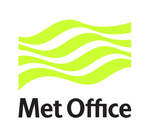Hadley Centre SST data set (HadSST2)
We corrected a minor bug in the error ranges provided
for HadSST2 (the best estimate data are unchanged). If you have
downloaded HadSST2 before November 20th 2007 please see
this page.
The Met Office Hadley Centre's sea surface temperature data
set, HadSST2 is a monthly global field of SST on
a 5° latitude by 5° longitude grid from 1850 to date. The data are neither interpolated nor variance adjusted.
Fields for the
latest available month (see for example the image below which shows
sea-surface temperature anomalies
for the most recent available month. A plus sign in any grid box indicates
that the temperature anomaly in that grid box this month is the highest
since the dataset starts in January 1850. Similarly a minus sign signals
the lowest anomaly since 1850.
) are added to the
data set on or around the 10th of the next month. In the picture
white areas represent land and areas where there no SST observations were made.
Brief description of the data
The SST data are taken from the International Comprehensive
Ocean-Atmosphere Data Set, ICOADS,
from 1850 to 1997 and from the
NCEP-GTS from 1998 to the present.
HadSST2 is produced by taking in-situ measurements of SST from ships
and buoys, rejecting measurements which which fail quality checks,
converting the measurements to anomalies by subtracting climatological
values from the measurements, and calculating a robust average of the
resulting anomalies on a 5° by 5° degree monthly grid.
After gridding the anomalies, bias corrections are applied to remove
spurious trends caused by changes in SST measuring practices before
1942. The uncertainties due to under-sampling have been calculated for the
gridded monthly data as have the uncertainties on the bias corrections following the
procedures described in the paper.
For a detailed description of the dataset and its production process,
see the paper cited in the references section. We recommended you read this
before using the
data.

|
Commercial and media enquiries
You can access the Met Office Customer Centre, any time of the day or night by phone, fax or e-mail. Trained staff will help you find the information or products that are right for you.
Contact the Met Office Customer Centre |
|
Other information
Various diagnostics are produced from the
monthly gridded fields. These include images of monthly anomaly patterns, and
global and hemispheric time series.
Frequently Asked Questions.
Dataset produced in collaboration with:


